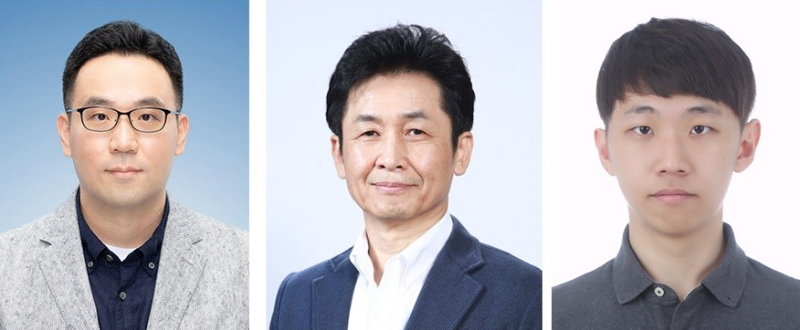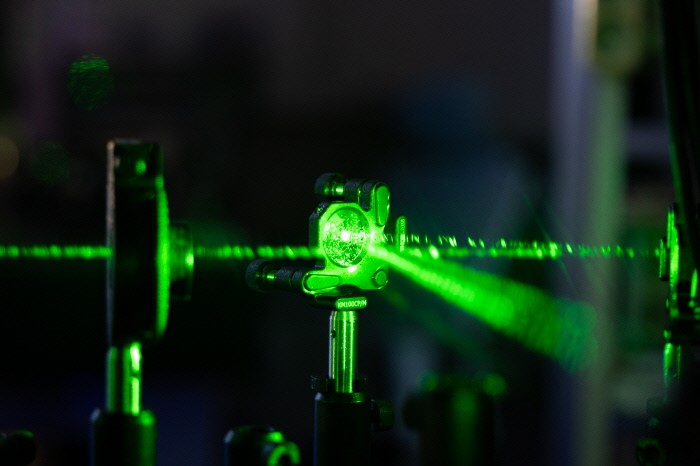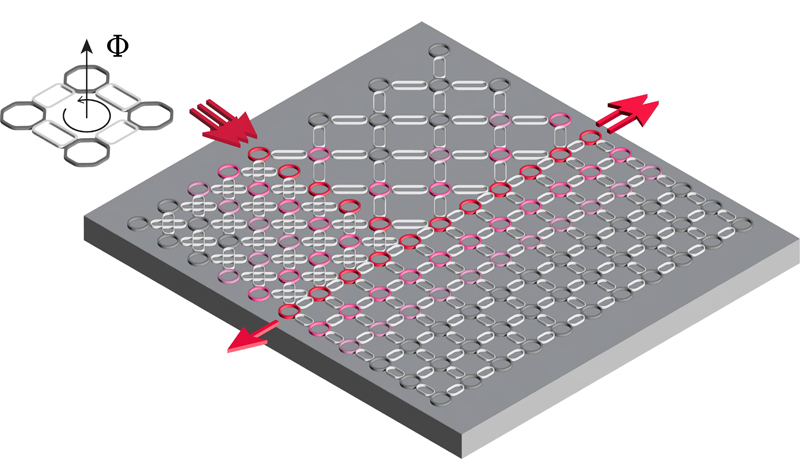Professors Sunkyu Yu and Namkyoo Park’s team at Seoul National University realized a platform for long-distance signal transport of high capacity optical information
- Overcomes trade-off between signal channel number and channel bandwidth by utilizing long-range connectivity
- Published in the renowned journal Light: Science & Applications on September 2nd

(From left to right) Prof. Sunkyu Yu (co-corresponding author), Prof. Namkyoo Park (co-corresponding author), and undergraduate researcher Gyunghun Kim (first author), Department of Electrical and Computer Engineering, Seoul National University
The College of Engineering at Seoul National University has announced that the research team led by Professors Sunkyu Yu and Namkyoo Park of the Department of Electrical and Computer Engineering has successfully realized a noise-resistant broadband signal processing platform by introducing topological design techniques to photonic integrated circuits.
In recent years, AI technologies that utilize graphics processing units (GPUs) have faced major challenges in terms of heat generation and power consumption. As a result, efforts are being made by NVIDIA, TSMC, Intel, and others to implement AI technologies utilizing light signals, which not only operate dozens of times faster than electronic devices, but also consume much less energy and heat. However, the major challenge with these optical AI technologies is that the flow of light is too sensitive to changes of systems, making it difficult to achieve the stability required for commercialization. Unlike existing optical systems, the system proposed in this work enables topologically protected, multichannel-based broadband signal processing by building hardware to exploit long-range interactions. This brings us one step closer to the commercialization of ultra-fast and low-power photonic AI.
The research was published on September 2 in Light: Science & Applications (IF = 20.6, JCI top 2.08%), a world-leading journal in the field of optics.
Topological physics, which focuses on the physical quantities that are preserved when an object is continuously deformed, is of broad interest in the fields of quantum computing, solid-state physics, optics, and electronic circuits because it enables noise-resistant computation and signal processing. In particular, in the field of photonic integrated circuits, which aims to perform computations by controlling the precise flow of light, efforts to realize noise-resistant optical signal processing platforms using topologically protected states of light have been intensively pursued over the past decade.
One of the main challenges in commercializing this research subject is overcoming the limitations of signal processing bandwidth. When utilizing the nearby interactions between devices in a photonic circuit implemented in two dimensions to achieve topological properties, there is a trade-off between the number of signal channels and the bandwidth of each channel, making it physically impossible to scale the entire bandwidth (number of channels × bandwidth) of the signal processing operation. This greatly hinders the ability to perform ultra-fast computations, which is the biggest advantage of optical signaling.

(Fig. 1) Laser beam splitting function as an example of light signal information processing
By introducing the concept of long-range interactions between optical elements, the research team of Professors Sunkyu Yu and Namkyoo Park of Seoul National University's Department of Electrical and Computer Engineering has realized the world's first multi-channel topologically protected optical platform that enables wide bandwidth realization in two dimensions. The platform utilizes topological properties to make it highly resistant to fabrication errors or operation noises that can occur during device fabrication. This is a major advantage for the commercialization of optical integrated circuits that are highly sensitive to errors on the order of tens of nanometers (billionths of a meter) or temperature changes of a few to tens of degrees.
In particular, by demonstrating hardware that enables long-range interactions within a two-dimensional photonic circuit, the team has shown that it is possible to overcome the trade-off between the number of topologically protected signal channels and the bandwidth of each channel. This approach allows us to realize larger topological charges without compromising bandwidth. This demonstrates the feasibility of broadband multichannel signal processing in silicon photonic integrated circuits that remains robust to various defects.

(Fig. 2) Conceptual diagram of multichannel topological energy splitting with the concept of long-range interactions: Different topological charges are designed for each region, and beam splitting is achieved through noise-resistant edge modes, and this structure enables beam splitting operation with a large signal bandwidth and very high error tolerance
Gyunghun Kim, the first author of the paper, stated, "In previous works, photonic topological circuits utilizing nearby interactions were implemented, but there was a fundamental issue where increasing the number of channels resulted in a narrower channel bandwidth." He added, "By solving the channel bandwidth issue through long-range interactions, signal processing in photonic integrated circuits has become more efficient and reliable."
Professors Sunkyu Yu and Namkyoo Park, co-corresponding authors of the paper, noted, "This research enables robust signal processing in silicon photonic integrated circuits, which are widely used in AI and quantum computing. The technology can be directly applied to topologically protected photonic memory and optical computing devices. Essentially, it models higher-dimensional physical phenomena on a 2D plane."
This research was led by Gyunghun Kim (first author, currently pursuing a PhD at MIT) and Joseph Suh (second author, currently pursuing a PhD at UC Berkeley) during their undergraduate internship programs. The project was supported by the Basic Research Laboratory (BRL) Program of the Ministry of Science and ICT (for research on memristive devices based on electron-photon hybrids), as well as the Mid-Career Researcher Program, the Excellent Young Researcher Program, and the Creative-Pioneering Researchers Program at Seoul National University.
[Contact Information]
Professor Sunkyu Yu, Department of Electrical and Computer Engineering, Seoul National University / +82-2-880-7281 / sunkyu.yu@snu.ac.kr
Professor Namkyoo Park, Department of Electrical and Computer Engineering, Seoul National University / +82-2-880-1820 / nkpark@snu.ac.kr



